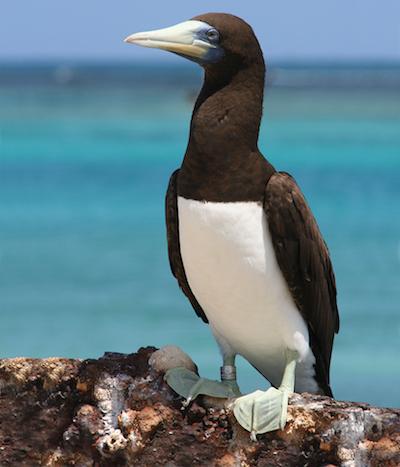
In a possible sign that climate change is altering bird territories, Brown boobies are now nesting in Channel Islands National Park/Duncan Wright via NPS
They were not supposed to be there, but they were: More than 100 brown-hooded, white-breasted seabirds, along with four nests, at chilly Channel Islands National Park off California's coast. This was not balmy Baja California, which normally is the northern-most range for tropics-loving Brown boobies, but rather a windswept chain of islands with average high temperatures in the mid-60s and brisk water temperatures in the 50s.
While the islands that comprise the national park have been called the "Galapagos of North America," Brown boobies are still an unusual addition. Yet their move north could be among the first of many by bird species trying to adapt to warming climates brought on by the world's growing greenhouse gas emissions.
“This discovery, once again, demonstrates the importance of the Channel Islands as critical seabird habitat,” park Superintendent Russell Galipeau said last November when the birds were spotted on Santa Barbara Island. “This makes for a total of 14 species of breeding seabirds, birds that rely upon the rich marine resources and the isolation of these offshore islands to provide food and undisturbed nesting grounds safe from predators.”
But the appearance of Brown boobies that far north might also signal the impact climate change is having on bird species. An expansive study on Birds and Climate Change that the National Audubon Society and National Park Service released Wednesday projects an upheaval of the species you're accustomed to seeing in national parks. Some species will move out, others will move in. On average, there could be up to a 25 percent turnover of bird species in some national parks by 2050. For instance:
* Bald eagles might not be seen in Grand Canyon National Park in Arizona during the winter;
* Mountain bluebirds might no longer be found in the mixed-grass prairies of Badlands National Park in South Dakota;
* Clark's nutcrackers could be vanishing from the pine forests Yellowstone National Park in Wyoming;
* Red-breasted nuthatches could disappear from the hardwood forests of Acadia National Park in Maine, and;
* Anhingas might not only be in decline at Everglades National Park in Florida, but they might also find temperatures at Grand Canyon more to their liking.
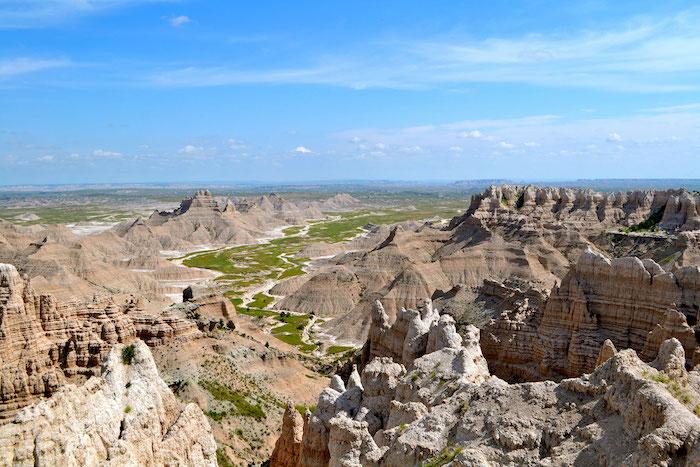
Climate change could drive Mountain bluebirds from Badlands National Park/NPS
Climate-Driven Species
As for Brown boobies, they were not reflected in the study as a newcomer to Channel Islands because the focus was on the potential shifting of species typically found now in the United States, said Dr. Gregor Schuurman, an adaptation ecologist with the Park Service's Climate Change Response Program who worked with Audubon's scientists on the research. But, he added, it's a good example of what the research is predicting.
“I think one could put it as a question: Why is the Brown booby in Channel Islands here in 2017?" he said during a phone conversation from his Fort Collins, Colorado, office. "I think an answer from folks who have kind of done the work that we’re doing is it’s certainly plausible that this has to do with unprecedentedly warm conditions, or other things that have allowed this species range to expand northward. We can’t point to our own study and say, 'Yes, there’s the entry in the table.' It’s not one of our species. So I would call it a bit more hypothetical. But it’s certainly consistent with the kind of modeling that we’ve done.”
The modeling in the study takes into account both high-level greenhouse gas emissions and low-level emissions and how they might lead to climate suitability for bird species in the National Park System by 2050. Much of the outlook hinges on the higher emissions level "because that seems to be the pathway we’re on now," Dr. Schuurman explained. Species data for the modeling came from both the North American Breeding Bird Survey and the Audubon Christmas Bird Count, the latter a 118-year-long community-based bird tracking project.
While Dr. Schuurman calls the study a rather straightforward, "fairly coarse-scale analysis" of climatic variables and shifts, it also should be viewed as thought-provoking, conversation-stimulating, and perhaps even disconcerting when you consider park landscapes under these climate changes.
Imagine, at Denali National Park and Preserve in Alaska, which is warming twice as fast as the rest of the country, "40 bird species could move in during summer. By 2050, Denali visitors may see forest birds like Western tanagers, Yellow-bellied Sapsuckers, and Rose-breasted Grosbeaks breeding in the park along with Magnolia, Canada, and other warblers seeking refuge in this cooler, northern forest."
Across the country in Shenandoah National Park in Virginia, while some species that breed in the park, such as warblers and thrushes, find the warming temperatures intolerable and head elsewhere, milder winter months might attract 43 species new to the park. "These include several birds, like the Common Yellowthroat and Vesper Sparrow, that currently breed or migrate through Shenandoah, and may begin wintering there, too," the study notes.
At Acadia and Voyageurs national parks, boreal chickadees might be seen only in birding field guides. Ring-necked ducks and Common loons could disappear from Biscayne National Park in Florida, though the Neotropic cormorant might decide to colonize the park. Yosemite National Park in California could lose the Great Horned Owl, but, hard as it might be to imagine, gain the Great roadrunner.
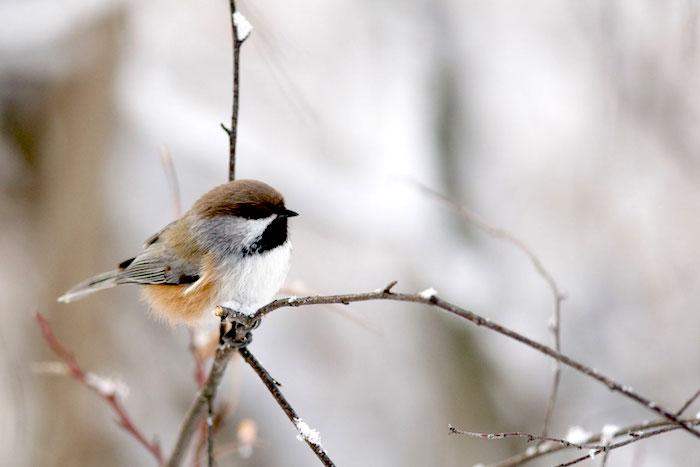
Boreal chickadees could vanish from Voyageurs and Acadia national parks/CalgaryBirder_Flickr CC BY 2.0
Symbiotic Ecosystem Change
But not only would birders in the parks have to recalibrate their expectations, ecosystems could be made over to a certain degree.
"On average, we’re talking about a large amount of change. One-quarter of the birds found in each of these parks, on average, is going to be a different bird in the future," said Dr. Chad Wilsey, director of conservation science for the National Audubon Society. "This is going to have ecological cascading effects and the potential to impact not just the birds themselves, but the ecosystems that may be influenced by them."
What sort, if any, of symbiotic relationship birds have with their surroundings could be altered by significant turnover in the types of species that make these parks home for all or part of the year, he said.
With Clark's nutcrackers expected under current climate projections to decline (if not vanish) in Yellowstone, Grand Teton, Great Basin, North Cascades, Mount Rainier, and Lassen Volcanic national parks, will another bird species step in to fill the role of "nature's gardener" that the nutcrackers have served, specifically in distributing the seeds of Whitebark pine? And if not, will squirrels be able to do just as good a job when it comes to reseeding the pines with their caches, or will that pine species also decline? And if it does, what about species such as grizzly bears that rely on the Whitebark's pinenuts as a valuable source of protein?
At Rocky Mountain National Park, will the possible loss of the migratory Bohemian Waxwing be offset by improving flocks of Cedar Waxwings? Will the Redwing blackbird be missed at Big Meadows in Shenandoah, and what changes might the Cattle egret bring to that park if it finds suitable habitat to go along with comfortable temperatures?
“There could be big changes coming, even in national parks protected from other impacts," said Joanna Wu, a National Audubon Society biologist who was the lead author on the paper that detailed the research. "We project an average turnover, or change in species composition, of 23 percent in the next couple decades. That’s a vast change in the number of species and their identities, so the ecosystem implications, it’s hard to predict, to be honest. First of all, it depends on which species that we predict to colonize or become extirpated would actually do so.
"Some may choose to adapt, or never make it to the parks that we say they may for other reasons," she added. "And then, of course, a whole new set of ecological interactions will come into play that we can’t fully predict. But suffice to say, some degree of change is definitely predicted for parks.”
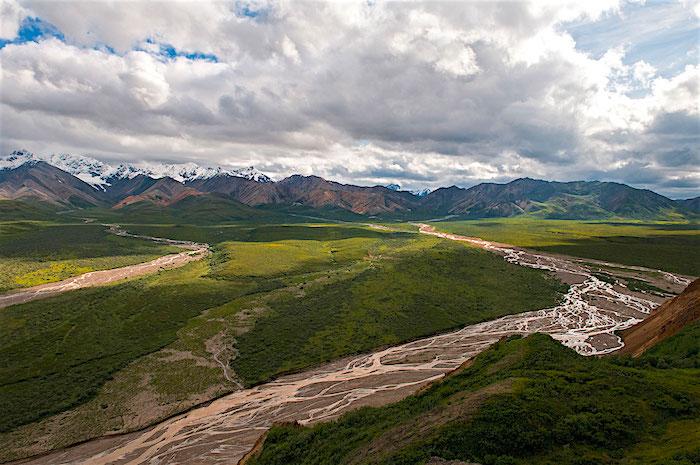
A warming climate could bring dozens of bird species not now in Denali National Park to the park by 2050/NPS, Tim Rains
And while park temperatures might change and become more suitable for some bird species, birds trying to adjust to climate change might pass up those parks if they lack suitable habitat.
"That’s kind of an interesting projection, for sure," Dr. Wilsey said of the predicted climatic suitability of the Grand Canyon for Anhingas. "A species that’s found more in the South, and associated with water. Again, we’re not saying definitively that these species will be there, but that the climatic conditions that are projected to be found in the Grand Canyon are similar to the climates that Anhingas are in today. So, it just tells you how much things are expected to change.
"... Certainly, we’re not trying to say that all these projections are guaranteed to come true," he added a bit later. "I think we just need to be open and acknowledge the fact that climatic conditions are one thing and habitat is separate.”
Will Refugia Shelter Species?
Also entirely possible is that microclimates could be found in some parks and create a refugia of sorts for species. According to research published back in 2014, "Between 10 percent to 28 percent of the world is located in potential refugia or less vulnerable areas. ... In the United States, up to one half of the National Park System is in potential refugia."
And back in 2012, a panel appointed by former Park Service Director Jon Jarvis to "revisit" the groundbreaking Leopold Report of the early 1960s noted that climate-change-proof habitats that can serve as refugia for species existed in the National Park System, which in turn could serve "as the core of a national conservation network of connected lands and waters."
"I think we absolutely expect those to occur," Dr. Wilsey said of refugia. "I think it’s just important to be aware that that is a way that species have adapted to climate change in geological time, and we expect them to do the same thing now."
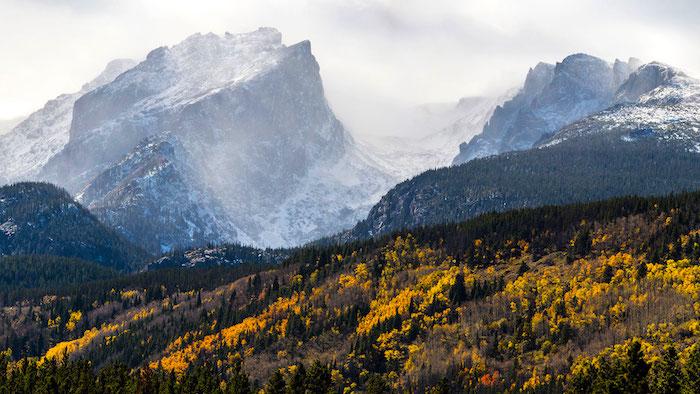
It's possible that refugia in parks, such as Rocky Mountain, could keep pockets of today's bird species in those parks as climate warms/NPS, Jacob W. Frank
Refugia, for example, might allow a specific species to "hang on longer than our models suggest," he said. "There will be places in our parks where smaller populations can hang on. That’s definitely one way that species will adapt to climate change."
Dr. Schuurman agreed.
"One of the things that we acknowledge in (the report) is that how and whether species respond to these changes will be governed by other factors. Right habitat availability, biotic interactions," he explained. "And one of the other ones we said was the availability of microclimates. So refugia are an important wrinkle that might influence how things play out."
A New Management Paradigm?
Something else that could be an "important wrinkle" is whether, and how, the National Park Service manages natural resources as climate changes. The agency long has been guided by the principle of allowing natural processes to play out. With that in mind, how active might the agency become in trying to manage their parks for specific species?
As the recent decision at Isle Royale National Park in Michigan to transport 20-30 wolves into the park with hopes they'll bring the moose population more into balance with the available vegetation shows, the agency's approach to be more hands on in that regard seems to be changing.
Indeed, in addressing "management implications" of the research, the report's authors suggest that, "(P)arks anticipating low change can best support landscape-scale bird conservation by emphasizing habitat restoration, maintaining natural disturbance regimes, and reducing other stressors. Furthermore, park managers have an opportunity to focus on supporting the ... species that are highly sensitive to climate change across their range."
Dr. Schuurman suggested that the Park Service needs to be open-minded in dealing with climate change and the issues it brings to their doorstep.
“On the one hand, these are challenging questions. On the other hand they’re really stimulating and fascinating and they do send you all the way back to fundamental questions, which you’re asking: What are we supposed to be doing and how does the world changing around our parks and in our parks influence that conception. This is tough stuff," said Dr. Schuurman.
“Gnarly issues," he went on, referring to "(T)hose issues related to management and adapting to ongoing and projected change in our resources where policy really doesn’t speak well to these circumstances. It doesn’t really imagine a world in which four out of five parks already are at the extreme warm edge or beyond their historical variability and temperature, and we’re already there today.
“This is very stimulating, and this is an opportunity when we have these difficult, gnarly conversations about gnarly issues. This is an important opportunity for us to think about how we’re stewarding resources and how best we can do it in this context.”
More details of the study and its findings can be found on the National Audubon Society website.



Comments
No, it's not about my tenure. But someone brought it up and I was glad to set them straight. Nor should Dr. Lemons be all that confident he stands on higher moral ground. Okay, I get it. We're the historical polluters and so we need to do penance before insisting we have cleaned up our act.
I hear it all the time in Seattle. Just this past Thursday, the court struck down the city's new tenant law. As of last year, landlords were supposed to pick tenants on a first-come, first-serve basis. No questions asked. No background check allowed. You had to take the first person who wanted to rent your property.
Defeated in court, the city will now appeal. A gut-feeling, insists City Council, is discriminatory. The landlord may be a "good person," but how is the city to know? The discrimination may be subliminal--and that the city cannot allow.
What the Constitution calls the confiscation of private property is instead "to level the playing field." That is what I hear when someone turns climate change into another morality play. I hear Big Brother knocking--not a scientist, and certainly not someone with common sense. Never in history has the playing field been leveled--in anything. The people calling for that are often the worst offenders, starting with Al Gore. Reads his business card: "Have private jet, will travel. You, dear boy, can take the bus."
The same fossil fuels being condemned here got hundreds of millions of people on their feet. Sure--those living downwind of the power plant are more affected than those living upwind. It's Environmental Studies 101. If on the other hand it's Morality 101, you will have to do better than complain about something that lifted millions of people out of poverty, or to saddle them with eternal damnation for having lived in a country with that talent.
Should we stop with fossil fuels? Who's saying that? But don't tell me that India, China, Brazil--whatever--are the saints in this morality play. The reason the Dreamers want to stay here--and not emigrate "there"--is because they know the difference. They know an exceptional country when they see one, even if the University of Washington, Seattle City Council, etc., etc., wish to replace the word exceptional with guilt. You're a nice man, Alfred Runte, but deep down you know you discriminate. We'll protect you from yourself.
So far, I'm guilty of white privilege, slavery, sexism, and racism. You might as well throw "historical emissions" in there, too. Just don't lose sight that the people making such arguments have absolutely no interest in the truth. It remains for them, as for so many in the past, the most convenient way to win the argument. I can see that I missed nothing in higher education these past 25 years, and therein lies the tragedy. It was once an experience not to be missed, and no, I never told my students they were guilty of anything. Back then, it was not about failing the argument, but rather about failing them.
Dr Lemon --- Do the international and intergovermental groups you've worked with have a plan to address the effects of landlord-tenant law in one city on global climate change?
Guilt? I for one feel no guilt about being fortunate enough to have been born in the country that I dearly love. We are blessed in many ways, which is why so many people are clamoring to get here, but to those of us who are so fortunate, more is expected. Why shouldn't we take at least some steps to lessen our impact on the environment? I certainly didn't invest in solar panels or a hybrid car to save money; they may not pay for themselves in my lifetime. But they represent at least a modest attempt to reduce the amount of carbon I contribute to climate change. Why can't our country as a whole do the same? Yes, I believe we are all adding to global warming, but the answer is not to give up and hope the earth's inhabitants will somehow adapt. The answer is to do SOMETHING. As I said here earlier, if we find ourselves in a hole, the first step is to stop digging.
And I say, if you are standing on top of a mountain, the last step is to start digging a hole. The poverty level in the US is 2x the median income of the rest of the world. We didn't get there chasing windmills. Leaving people in poverty by implementing anti growth policies is the true moral outrage.
The future of job growth and economic prosperity is in green energy. But don't take my word for it. Go invest in a coal mine.
Maybe, but while you are waiting for the future, I will buy oil, gas and coal based energy as it is the most economic in the present. And I suspect you will as well.
BTW - Peabody Energy, the largest coal pure play had revenues of $5.6 billion in 2017 up 18% from 2016. It had EBITDA of 1.5 billion nearly triple the prior year and the stock is up more than 60% over the last year. Not a bad investment.
"Suspect" again, EC. I won't invest in any industry that it harming the planet and my fellow humans. Some things are more important then money.